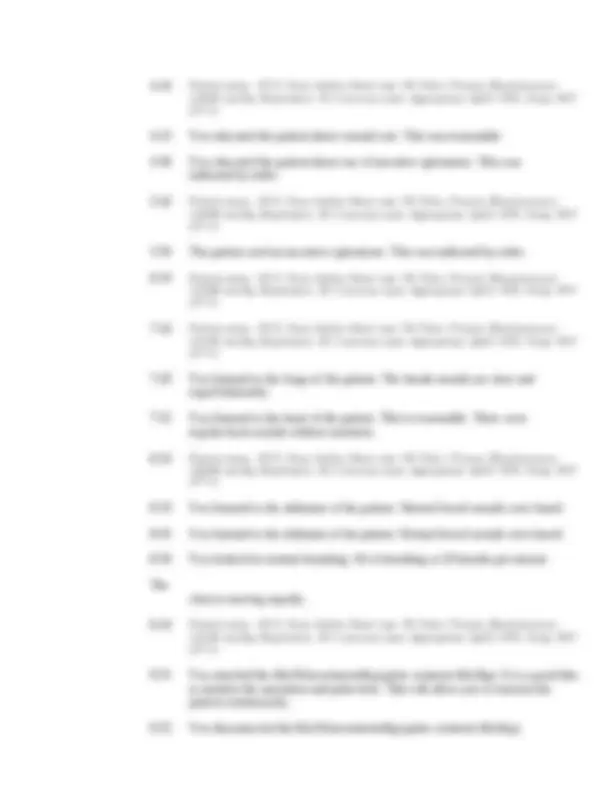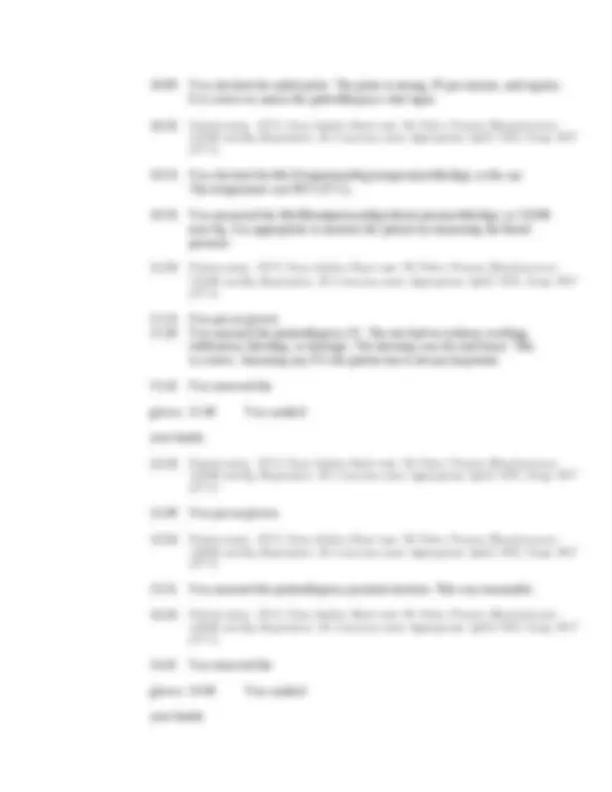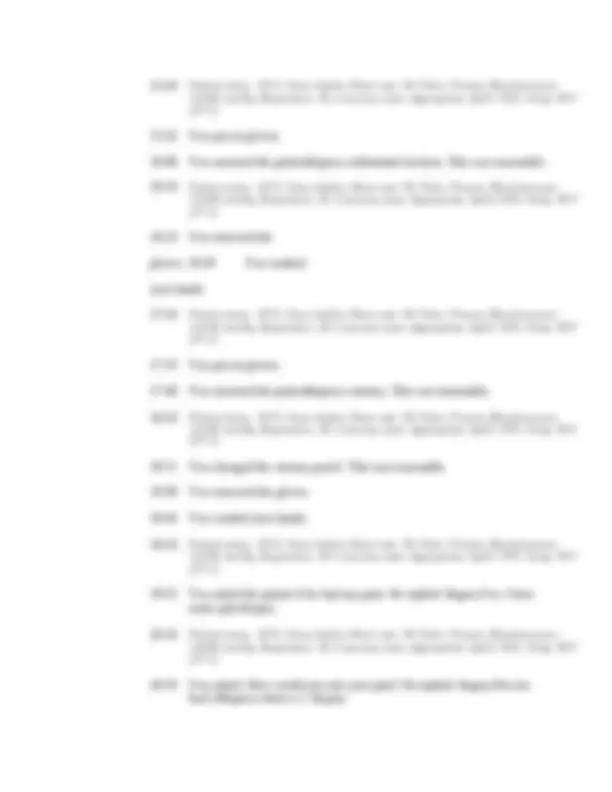





Study with the several resources on Docsity

Earn points by helping other students or get them with a premium plan


Prepare for your exams
Study with the several resources on Docsity

Earn points to download
Earn points by helping other students or get them with a premium plan
Community
Ask the community for help and clear up your study doubts
Discover the best universities in your country according to Docsity users
Free resources
Download our free guides on studying techniques, anxiety management strategies, and thesis advice from Docsity tutors
A case of a male patient diagnosed with rectal cancer who underwent a laparoscopic abdominal perineal resection with a permanent colostomy. The document details the basic assessments of the stoma and incision, a focused gastrointestinal assessment, and patient education on colostomy care. It also provides information on how to prevent complications such as retraction, bleeding, or compromised circulation.
Typology: Study notes
1 / 6

This page cannot be seen from the preview
Don't miss anything!




Apr 08, 2021 01:37 AM Age: 43 years Diagnosis: Rectal cancer
0:00 You arrived at the patient's side. 0:00 You reviewed the patient information. 0:00 You reviewed the patient log. 0:00 You reviewed the diagnostics. 0:00 You reviewed the clinical observations. 0:00 You reviewed the MAR. 0:00 You reviewed the orders. 0:00 You reviewed the intake and output. 0:10 You washed your hands. To maintain patient safety, it is important to wash your hands as soon as you enter the room. 1:10 Patient status - ECG: Sinus rhythm. Heart rate: 94. Pulse: Present. Blood pressure: 132/85 mm Hg. Respiration: 19. Conscious state: Appropriate. SpO2: 95%. Temp: 99 F (37 C) 1:22 You introduced yourself. This was reasonable. 1:37 You identified the patient. To maintain patient safety, it is important that you quickly identify the patient. 1:52 You asked if the patient was <Allergy>allergic<> to anything. He replied: 'No, I am not allergic to anything.' 2:10 Patient status - ECG: Sinus rhythm. Heart rate: 94. Pulse: Present. Blood pressure: 129/84 mm Hg. Respiration: 19. Conscious state: Appropriate. SpO2: 95%. Temp: 99 F (37 C) 2:18 You asked the patient how he felt. He replied: 'I am embarrassed about the smell.' 2:57 You educated the patient about ostomy care. 3:10 Patient status - ECG: Sinus rhythm. Heart rate: 94. Pulse: Present. Blood pressure: 132/86 mm Hg. Respiration: 19. Conscious state: Appropriate. SpO2: 95%. Temp: 99 F (37 C) 3:39 You educated the patient about diet. This was reasonable.
10:09 You checked the radial pulse. The pulse is strong, 95 per minute, and regular. It is correct to assess the patient's vital signs. 10:10 Patient status - ECG: Sinus rhythm. Heart rate: 94. Pulse: Present. Blood pressure: 132/85 mm Hg. Respiration: 18. Conscious state: Appropriate. SpO2: 95%. Temp: 99 F (37 C) 10:33 You checked the <Temperature>temperature<> at the ear. The temperature was 99 F (37 C). 10:54 You measured the <Bloodpressure>blood pressure<> at 132/ mm Hg. It is appropriate to monitor the patient by measuring the blood pressure. 11:10 Patient status - ECG: Sinus rhythm. Heart rate: 94. Pulse: Present. Blood pressure: 132/85 mm Hg. Respiration: 18. Conscious state: Appropriate. SpO2: 95%. Temp: 99 F (37 C) 11:14 You put on gloves. 11:28 You assessed the patient's IV. The site had no redness, swelling, infiltration, bleeding, or drainage. The dressing was dry and intact. This is correct. Assessing any IVs the patient has is always important. 11:42 You removed the gloves. 11:48 You washed your hands. 12:10 Patient status - ECG: Sinus rhythm. Heart rate: 94. Pulse: Present. Blood pressure: 129/84 mm Hg. Respiration: 18. Conscious state: Appropriate. SpO2: 95%. Temp: 99 F (37 C) 12:49 You put on gloves. 13:10 Patient status - ECG: Sinus rhythm. Heart rate: 94. Pulse: Present. Blood pressure: 130/85 mm Hg. Respiration: 18. Conscious state: Appropriate. SpO2: 95%. Temp: 99 F (37 C) 13:31 You assessed the patient's perineal incision. This was reasonable. 14:10 Patient^ status^ -^ ECG: Sinus^ rhythm.^ Heart^ rate: 94.^ Pulse: Present.^ Blood^ pressure: 130/85 mm Hg. Respiration: 18. Conscious state: Appropriate. SpO2: 95%. Temp: 99 F (37 C) 14:41 You removed the gloves. 14:48 You washed your hands.
15:10 Patient status - ECG: Sinus rhythm. Heart rate: 94. Pulse: Present. Blood pressure: 132/85 mm Hg. Respiration: 18. Conscious state: Appropriate. SpO2: 95%. Temp: 99 F (37 C) 15:52 You put on gloves. 16:08 You assessed the patient's abdominal incision. This was reasonable. 16:10 Patient^ status^ -^ ECG: Sinus^ rhythm.^ Heart^ rate: 94.^ Pulse: Present.^ Blood^ pressure: 132/85 mm Hg. Respiration: 18. Conscious state: Appropriate. SpO2: 95%. Temp: 99 F (37 C) 16:23 You removed the gloves. 16:29 You washed your hands. 17:10 Patient status - ECG: Sinus rhythm. Heart rate: 94. Pulse: Present. Blood pressure: 131/85 mm Hg. Respiration: 18. Conscious state: Appropriate. SpO2: 95%. Temp: 99 F (37 C) 17:33 You put on gloves. 17:48 You assessed the patient's ostomy. This was reasonable. 18:10 Patient status - ECG: Sinus rhythm. Heart rate: 94. Pulse: Present. Blood pressure: 131/85 mm Hg. Respiration: 18. Conscious state: Appropriate. SpO2: 95%. Temp: 99 F (37 C) 18:11 You changed the ostomy pouch. This was reasonable. 18:38 You removed the gloves. 18:44 You washed your hands. 19:10 Patient status - ECG: Sinus rhythm. Heart rate: 94. Pulse: Present. Blood pressure: 132/85 mm Hg. Respiration: 18. Conscious state: Appropriate. SpO2: 95%. Temp: 99 F (37 C) 19:52 You asked the patient if he had any pain. He replied: 'Yes, I have some pain.' 20:10 Patient status - ECG: Sinus rhythm. Heart rate: 94. Pulse: Present. Blood pressure: 130/85 mm Hg. Respiration: 18. Conscious state: Appropriate. SpO2: 95%. Temp: 99 F (37 C) 20:10 You asked: How would you rate your pain? He replied: 'Not too bad; it's about a 1. '